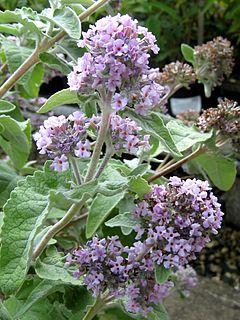
Buddleja crispa, sometimes called the Himalayan butterfly bush, is native to Afghanistan, Bhutan, North India, Nepal, Pakistan and China, where it grows on dry river beds, slopes with boulders, exposed cliffs, and in thickets, at elevations of 1400–4300 m. Named by Bentham in 1835, B. crispa was introduced to cultivation in 1850, and came to be considered one of the more attractive species within the genus; it ranked 8th out of 57 species and cultivars in a public poll organized by the Center for Applied Nursery Research (CANR) at the University of Georgia, USA.. In the UK, B. crispa was accorded the Royal Horticultural Society's Award of Merit in 1961. However, the species is not entirely cold-hardy, and thus its popularity is not as ubiquitous as it might otherwise be.

Buddleja colvilei is endemic to the eastern Himalaya; discovered by Hooker in 1849, he declared it 'the handsomest of all Himalayan shrubs.' In 1896 the species was awarded the RHS First Class Certificate (FCC), given to plants 'of outstanding excellence for exhibition'.
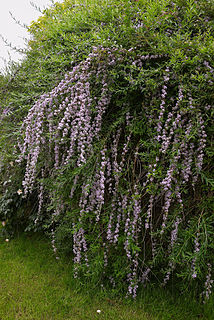
Buddleja alternifolia, known as alternate-leaved butterfly-bush, is a species of flowering plant in the figwort family, which is endemic to Gansu, China. A substantial deciduous shrub growing to 4 metres (13 ft) tall and wide, it bears grey-green leaves and graceful pendent racemes of scented lilac flowers in summer.

Buddleja fallowiana is a species of flowering plant endemic to the Yunnan province of western China, where it grows in open woodland, along forest edges and watercourses. The plant was collected in China by Forrest in 1906, and named in 1917 by Balfour & Smith for George Fallow, a gardener at the Royal Botanic Garden Edinburgh who had died in Egypt in 1915 from wounds sustained fighting in the Gallipoli Campaign.
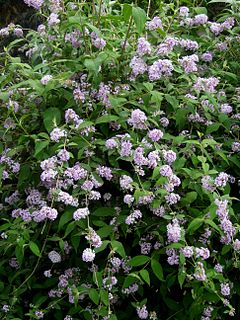
Buddleja delavayi is a Chinese species discovered by Forrest in the Tali Range above Dali, Yunnan, in 1910; it is also found in Xizang (Tibet). The species was named for l'Abbé Delavay, the French missionary and plant collector, by Gagnepain in 1912. The shrub is of interest to the botanist because of its unique resting buds and the different types of inflorescence produced through the year.

Buddleja officinalis is a deciduous early-spring flowering shrub native to west Hubei, Sichuan, and Yunnan provinces in China. Discovered in 1875 by Pavel Piasetski, a surgeon in the Russian army, B. officinalis was named and described by Maximowicz in 1880. Introduced to western cultivation in 1908, B. officinalis was accorded the Royal Horticultural Society's Award of Merit three years later, and the Award of Garden Merit in 2002.
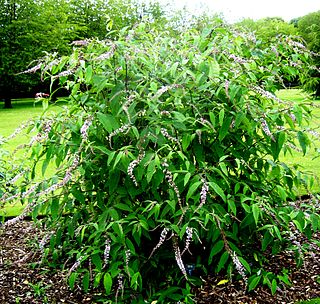
Buddleja albiflora is a deciduous shrub native to the mountains of central China, where it grows on shrub-clad slopes at altitudes of between 1,000 and 2,000 m. Named rather carelessly by Hemsley, the species was discovered by Henry, and introduced to western cultivation by Wilson in 1900.

Buddleja agathosma is endemic to western Yunnan, China. Originally identified as B. agathosma by Ludwig Diels, it was sunk as Buddleja crispa by Leeuwenberg in 1979, and treated as such in the subsequent Flora of China published in 1996. However, the shrub remains widely known by its former epithet in horticulture.

Buddleja asiatica is a somewhat tender deciduous shrub native to a vast area of the East Indies, including India, Nepal, Bangladesh, China, Taiwan, Burma, Thailand, Laos, Cambodia, Vietnam, Malaysia, New Guinea, and the Philippines, growing in open woodland at elevations < 2,800 m either as understorey scrub, or as a small tree. First described by Loureiro in 1790, B. asiatica was introduced to the UK in 1874, and accorded the RHS Award of Garden Merit in 1993. It is highly invasive in Hawaii, Guam, and the Northern Mariana Islands.

Buddleja japonica is a deciduous shrub native to Honshu and Shikoku, Japan, where it grows on mountain slopes amid scrub. The shrub was named and described by Hemsley in 1889, and introduced to Western cultivation in 1896.
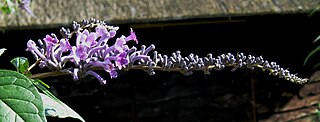
Buddleja lindleyana is a deciduous shrub native to the provinces of Anhwei, Hunan, Hupeh, Kiangsu, Shanghai, Sichuan, and Yunnan in China, where it grows in rocky scrub alongside streams and tracks at elevations of 200 – 2700 m. The shrub has also naturalized on Okinawa-jima, Japan, and in the south-eastern states of the United States.

Buddleja nivea is a vigorous shrub endemic to western China, evergreen in the wild, but deciduous in cultivation in the UK. The plant was discovered by Wilson in the Yangtze basin at altitudes of 700 – 3,600 m. Introduced to cultivation in 1901, it was named by Duthie in 1905. Several plants similar to the species but originally treated as species and varieties in their own right have now been sunk as B. nivea.
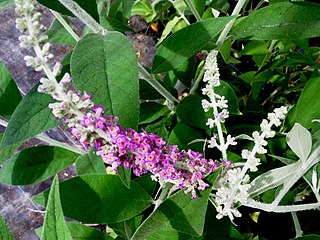
Buddleja stenostachya is a deciduous shrub native to Szechuan province, China. The species was discovered and introduced to cultivation by Wilson in 1908, and named by him and Rehder in 1913. There remains some contention over its taxonomy; it was sunk under B. nivea by Leeuwenberg; while another erroneously sank it as a variety of Buddleja crispa.

Buddleja yunnanensis is a vigorous shrub native to Yunnan and much of the rest of south-western China, where it grows on forest margins, thickets, and along streams at elevations of 1,000 – 2,500 m. The shrub was first described and named by Francois Gagnepain in 1915, however its taxonomy remains a matter of contention.
Buddleja curviflora is a deciduous shrub native to southern Japan and Taiwan, where it grows in thickets on stony slopes at elevations of 100–300 m. B. curviflora was named and described Hooker & Arnott in 1838. Plants in Taiwan have been described as a separate species Buddleja formosana and assessed as Critically Endangered by IUCN, but the distinction is not recognized by Li and Leeuwenberg, who sank formosana as a synonym.

Buddleja paniculata is a species of flowering plant in the figwort family Scrophulariaceae, endemic to a wide upland area from northern India to Bhutan, growing along forest margins, in thickets, and on rocky slopes at elevations of 500–3,000 m (1,600–9,800 ft). The species was named by Wallich and introduced to the UK in 1823 as seed sent by Major Madden from the Himalayas to the Glasnevin Botanic Garden.
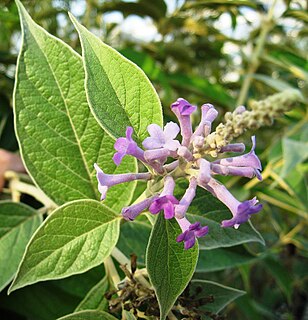
Buddleja myriantha is a species endemic to upper Burma and western China, including Tibet, where it grows along forest edges, thickets and streams at altitudes of 2,000 – 3,200 m. The species was first described and named by Diels in 1912.

Buddleja limitanea is a small deciduous shrub. Discovered by George Forrest in Yunnan (1912) and in northern Burma (1914), described by William Wright Smith in 1916. Resembling a small B. forrestii and hence sunk under this name by Leeuwenberg, although recognised in horticulture as a separate species.
Buddleja candida is a small deciduous shrub widely distributed from north-east India through south east Xizang (Tibet) to the provinces of Sichuan and Yunnan in western China, growing on forest edges, in mountain thickets, and along riverbanks, at altitudes of 1000 – 2500 m. Named and described by Dunn in 1920, the shrub was introduced to cultivation in the west in 1928.
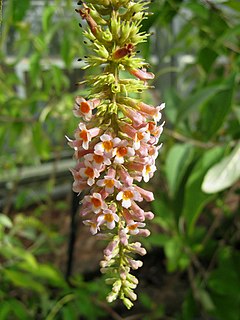
Buddleja macrostachya is a large deciduous shrub or small tree with a vast distribution, from Xizang (Tibet) through western China, Bhutan, Sikkim, northern India, Bangladesh, Myanmar (Burma), to Thailand and Vietnam, growing in scrub on mountain slopes to an altitude of 3,200 m, and along rivers in forests. The species was named and described by Wallich ex Bentham in 1835.



















